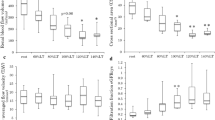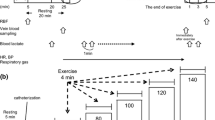Abstract
Purpose
High-intensity exercise reduces renal artery blood flow (RBF) compared to other forms of exercise. However, it is unclear whether moderate-intensity exercise, including those at the ventilation threshold (VT), decreases RBF. Additionally, attenuated renal autoregulation and associated blood flow can cause renal injury in patients with underlying disease. Therefore, this study aimed to confirm the changes in RBF after moderate-level exercise in healthy subjects, which will have implications for the study of renal arterial blood flow in patients with renal failure.
Methods
Cardiopulmonary exercise tests were performed by 10 healthy male participants (mean age, 31 ± 8 years): 3 min constant work-rate exercise tests, varying in exercise intensity 1 min before VT (pre-VT), after VT (post-VT), and after the respiratory compensation point (RCP). The RBF was measured using ultrasonic inspection equipment following each exercise. The VT was determined using the ventilatory equivalent method (VEQ method), while the RBF was calculated from the time-averaged flow velocity (TAV) and cross-sectional area (CSA).
Results
At baseline (resting phase), RBF was 461 ± 142 mL/min. While RBFs at pre-VT were not significantly different from those at baseline (482 ± 142 mL/min; P = 0.82), significant differences were observed at post-VT (289 ± 111 mL/min; P < 0.01 vs. baseline). RBFs at the RCP were also different from those at the baseline (212 ± 56 mL/min; P < 0.01 vs. baseline).
Conclusions
In healthy individuals, exercises varying in intensity up to the vicinity of the VT can be performed without any significant decrease in RBF.
Trial Registration Number and Registration Date
The trial was approved by an independent ethics committee at the Asahi University Hospital (approval No. 1/May/2018) and was registered (Name of the registry: Changes of renal blood flow with exercise load. Consideration using ultrasonic inspection equipment. UMIN000035598, https://center6.umin.ac.jp/cgi-open-bin/ctr/ctr_view.cgi?recptno=R000040561, 24/January/2019).





Similar content being viewed by others
Data Availability Statement
Upon a reasonable request, derived data supporting the findings of this study are available from the corresponding author.
References
Ana BP, Jesús JR, Francisco JC, Nicola M. Responses to increasing exercise upon reaching the anaerobic threshold, and their control by the central nervous system. BMC Sports Sci Med Rehabil. 2014;6:17. https://doi.org/10.1186/2052-1847-6-17.
Bellinghieri G, Savica V, Santoro D. Renal alterations during exercise. J Ren Nutr. 2008;18(1):158–64. https://doi.org/10.1007/BF00376487.
Chapman CL, Johnson BD, Hostler D, Lema PC, Schlader ZJ. Reliability and agreement of human renal and segmental artery hemodynamics measured using Doppler ultrasound. J Appl Physiol (1985). 2020;128(3):627–36. https://doi.org/10.1152/japplphysiol.00813.2019.
Christensen PK, Akram K, Kønig KB, Parving HH. Autoregulation of glomerular filtration rate in patients with type 2 diabetes during isradipine therapy. Diabetes Care. 2003;26(1):156–62. https://doi.org/10.2337/diacare.26.1.156.
Colombo R, Santos RA, Rech LS, Tonolli BT, Farina GS, Gerhardt GJL. An educational tool to improve understanding of angiotensin II function and the adrenergic system in renal circulation. Adv Physiol Educ. 2019;43(4):529–33. https://doi.org/10.1152/advan.00080.2018.
Daniel DS, Melinda S, Luigi P, Eleonora D, Devaki SS. Association of high-intensity exercise with renal medullary carcinoma in individuals with sickle cell trait: clinical observations and experimental animal studies. Cancers (Basel). 2021;13(23):6022. https://doi.org/10.3390/cancers13236022PMCID:PMC8656882. (PMID: 34885132).
Danielle LK, Bryce JM, Joseph MS, Raymond RT, David GE. Cardiopulmonary exercise testing reveals subclinical abnormalities in chronic kidney disease. Eur J Prev CardiolCardiol. 2018;25(16):1717–24. https://doi.org/10.1177/2047487318777777.
Davi AS, Jacques RP, Dórea EL, de Juliana BAM, Alan LF. Acute exercise does not impair renal function in nondialysis chronic kidney disease patients regardless of disease stage. Am J Physiol Renal Physiol. 2017;313:F547–52. https://doi.org/10.1152/ajprenal.00131.2017.
David RH, Catherine M, Kenneth M. The athletic horse: principles and practice of equine sports med. St. Louis: Elsevier/Saunders; 2014.
Edward JJ, Ulla CK, Gerald FD. Neural control of renal function. Compr Physiol. 2011;1(2):731–67. https://doi.org/10.1002/cphy.c100043.
Eva P, Afroditi B, Aristi B, Christodoulos EP, Aikaterini P, Pantelis S. Cardiopulmonary exercise testing in patients with end-stage kidney disease: principles, methodology and clinical applications of the optimal tool for exercise tolerance evaluation. Nephrol Dial Transplant. 2021. https://doi.org/10.1093/ndt/gfab150.
Fine LG, Norman JT. Chronic hypoxia as a mechanism of progression of chronic kidney diseases: from hypothesis to novel therapeutics. Kidney Int. 2008;74(7):867–72. https://doi.org/10.1038/ki.2008.350. (Epub 2008 Jul 16).
Koçer G, Kuru O, Gündüz F, Bayram Z, Ozdem S, Aksoy D, Sentürk UK. The effect of exercise training on the responsiveness of renal resistance arteries in rats. Ren Fail. 2011;33(6):587–92. https://doi.org/10.3109/0886022X.2011.585000.
Hamid A, Majid M, Payam S, Akram F, Katsuhiko S. Effects of different types of exercise on kidney diseases. Sports (Basel). 2022;10(3):42. https://doi.org/10.3390/sports10030042.
Honda S, Kawasaki T, kamitani T, Kiyota K. Rhabdomyolysis after high intensity resistance training. Intern Med. 2017;56(10):1175–8. https://doi.org/10.2169/internalmedicine.56.7636.9.
Jacques R, Jacques PV. Kidney function during exercise in healthy and diseased humans. Sports Med. 1994;18(6):419–37.
Kaufman D, Basit H, Knohl SJ. Physiology, glomerular filtration rate. Treasure Island (FL): StatPearls; 2022.
Kawakami S, Yasuno T, Matsuda T, Fujimi K, Ito A, Yoshimura S, Uehara Y, Tanaka H, Saito T, Higaki Y. Association between exercise intensity and renal blood flow evaluated using ultrasound echo. Clin Exp Nephrol. 2018;22(5):1061–8. https://doi.org/10.1007/s10157-018-1559-1.
Lei Y, Xiaoxia W, Ying W, Chunfeng W, Rong H. Effects of exercise training on proteinuria in adult patients with chronic kidney disease: a systematic review and meta-analysis. BMC Nephrol. 2020;21(1):172.
Marilyn B, Mallikarjuna RP, Jerry F, Richard JR. Molecular mechanisms of renal blood flow autoregulation. Curr Vasc Pharmacol. 2014;12(6):845–58.
Mattias C, Christopher SW, Arendshorst WJ. Renal autoregulation in health and disease. Physiol Rev. 2015;95(2):405–511. https://doi.org/10.1152/physrev.00042.2012.
Meola M, Petrucci I. Color Doppler sonography in the study of chronic ischemic nephropathy. J Ultrasound. 2008;11(2):55–73. https://doi.org/10.1016/j.jus.2008.03.006.
Poortmans JR. Exercise and renal function. Sports Med. 1984;1(2):125–53. https://doi.org/10.2165/00007256-198401020-00003.
Rahmy AF, Afifi WM, Ghorab AA, Mostafa HA. Effect of moderate aerobic exercises on kidney function and lipid profile in chronic kidney disease patients. JESNT. 2016;16(3):97–105.
Malpas SC, Leonard BL. Neural regulation of renal blood flow: a re-examination. Rev Clin Exp Pharmacol Physiol. 2000;27(12):956–64.
Sata Y, Head GA, Denton K, May CN, Schlaich MP. Role of the sympathetic nervous system and Its modulation in renal hypertension. Front Med (Lausanne). 2018;5:82. https://doi.org/10.3389/fmed.2018.00082.
Shiraishi Y, Katsumata Y, Sadahiro T, Azuma K, Akita K, Isobe S, Yashima F, Miyamoto K, Nishiyama T, Tamura Y, Kimura T, Nishiyama N, Aizawa Y, Fukuda K, Takatsuki S. Real-time analysis of the heart rate variability during incremental exercise for the detection of the ventilatory threshold. J Am Heart Assoc. 2018;7(1):e006612. https://doi.org/10.1161/JAHA.117.006612.
Spada TC, Silva JMRD, Francisco LS, Marçal LJ, Antonangelo L, Zanetta DMT, Yu L, Burdmann EA. High intensity resistance training causes muscle damage and increases biomarkers of acute kidney injury in healthy individuals. PLoS ONE. 2018;13(11): e0205791. https://doi.org/10.1371/journal.pone.0205791.
Sparks MA, Crowley SD, Gurley SB, Mirotsou M, Coffman TM. Classical renin-angiotensin system in kidney physiology. Compr Physiol. 2014;4(3):1201–28. https://doi.org/10.1002/cphy.c130040.
Steven E, Brent C, Ruby J, Sanchez A, Serfass C, Leon AS. Validity and reliability of combining three methods to determine ventilatory threshold. Med Sci Sports Exer. 2001;33(11):1841–8. https://doi.org/10.1097/00005768-200111000-00007.
Suzuki M, Sudoh M, Matsubara S, Kawakami K, Shiota M, Ikawa S. Changes in renal blood flow measured by radionuclide angiography following exhausting exercise in humans. Eur J Appl Physiol Occup Physiol. 1996;74(1–):1–7.
University hospital Medical Information Network (UMIN) Center. UMIN 000035598 - UMIN Clinical Trials. http://www.umin.ac.jp/.
Yamagata K, Hoshino J, Sugiyama H, Hanafusa N, Shibagaki Y, Komatsu Y, Konta T, Fujii N, Kanda E, Sofue T, Ishizuka K, Kitagawa M, Kono K, Hinamoto N, Miyai T, Koike K, Toda S, Hasegawa J, Yamanouchi M, Yoshimura R, Ishii R, Goto S, Kawarazaki H, Takase K, Taki F, Matsumura M, Raita Y, Sakurai S, Shimizu T, Yamanoto S, Kawaguchi T, Oguchi H, Tsujita M, Yazawa M, Uchida A, Ando Y, Kaneko S, Matsunaga A, Harada T, Ito O, Kohzuki M. Clinical practice guideline for renal rehabilitation: systematic reviews and recommendations of exercise therapies in patients with kidney diseases. Ren Replace Ther. 2019;5:28.
Yamamoto Y, Hughson RL, Nakamura Y. Autonomic nervous system responses to exercise in Relation to ventilatory threshold. Chest. 1992;101(Suppl):206S-S210. https://doi.org/10.1378/chest.101.5_supplement.206s.
Acknowledgements
The authors thank all members of the Department of Cardiology, Asahi University Hospital, and Shinichi Arizono.
Funding
The authors declare that no support, financial or otherwise, was received during the preparation of this manuscript.
Author information
Authors and Affiliations
Contributions
YF contributed to literature research, study design, data analysis, manuscript preparation, and manuscript review. SA contributed to study design, data analysis, and manuscript preparation. ST contributed to study design and data collection. TK, NT, TF, and JM contributed to data collection. YT contributed to data collection and study design. TS contributed to data collection. All authors read and approved the final manuscript.
Corresponding author
Ethics declarations
Conflict of Interest
Shinichi Arizono reports grants from Hoshi Iryo-Sanki Co. Ltd and NPO Central Japan Lung Study Group outside the submitted work. All other authors declare that they have no competing interests.
Ethics Approval and Consent to Participate
This trial was approved by an independent ethics committee at the Asahi University Hospital (Approval No. 1/May/2018) and was registered (Name of the registry: Changes of renal blood flow with exercise load. Consideration using ultrasonic inspection equipment.UMIN 000035598, https://center6.umin.ac.jp/cgi-open-bin/ctr/ctr_view.cgi?recptno=R000040561, 24/January/2019). All test subjects were volunteers who were informed about the details of the study. Written consent to participate was obtained from all the participants before enrollment in the study.
Consent for Publication
Not applicable.
Consent to Participate
Informed consent was obtained from all individual participants included in the study.
Rights and permissions
Springer Nature or its licensor (e.g. a society or other partner) holds exclusive rights to this article under a publishing agreement with the author(s) or other rightsholder(s); author self-archiving of the accepted manuscript version of this article is solely governed by the terms of such publishing agreement and applicable law.
About this article
Cite this article
Fukuta, Y., Arizono, S., Tanaka, S. et al. Effects of Exercise Around the Ventilation Threshold on Renal Blood Flow in Healthy Individuals. J. of SCI. IN SPORT AND EXERCISE 6, 44–51 (2024). https://doi.org/10.1007/s42978-022-00216-7
Received:
Accepted:
Published:
Issue Date:
DOI: https://doi.org/10.1007/s42978-022-00216-7




